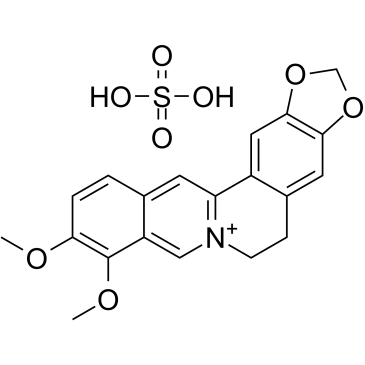
Berberine hydrogen sulphate
CAS No. 633-66-9
Berberine hydrogen sulphate( —— )
Catalog No. M18934 CAS No. 633-66-9
Berberine sulfate, an alkaloid extracted from several plants, possesses antimicrobial activity against a wide variety of microorganisms including Gram-positive and Gram-negative bacteria, fungi, and protozoa.
Purity : >98% (HPLC)
 COA
COA
 Datasheet
Datasheet
 HNMR
HNMR
 HPLC
HPLC
 MSDS
MSDS
 Handing Instructions
Handing Instructions
| Size | Price / USD | Stock | Quantity |
| 25MG | 76 | In Stock |


|
| 100MG | Get Quote | In Stock |


|
| 200MG | Get Quote | In Stock |


|
| 500MG | Get Quote | In Stock |


|
| 1G | Get Quote | In Stock |


|
Biological Information
-
Product NameBerberine hydrogen sulphate
-
NoteResearch use only, not for human use.
-
Brief DescriptionBerberine sulfate, an alkaloid extracted from several plants, possesses antimicrobial activity against a wide variety of microorganisms including Gram-positive and Gram-negative bacteria, fungi, and protozoa.
-
DescriptionBerberine sulfate, an alkaloid extracted from several plants, possesses antimicrobial activity against a wide variety of microorganisms including Gram-positive and Gram-negative bacteria, fungi, and protozoa.
-
In VitroCell Proliferation Assay Cell Line:Four colorectal carcinoma cell lines LoVo, HCT116, SW480, and HT-29 Concentration:1.25, 2.5, 5, 10, 20, 40, 80, and 160 μM Incubation Time:72 hours Result:Inhibited the proliferation of four cell lines. The IC50 ranged from 40.8±4.1 μM (LoVo) to 98.6±2.9 μM (HCT116).Cell Proliferation AssayCell Line:Colorectal carcinoma cell lines LoVo Concentration:1.25, 2.5, 5, 10, 20, 40, 80, and 160 μM Incubation Time:24, 48, 72 hours Result:Induced a time- and dose-dependent inhibition of cell growth. By 72 h, 160.0 μM induced 71.1±1.9 % growth inhibitions in LoVo cells.Cell Cycle Analysis Cell Line:LoVo cells Concentration:0, 10, 20, 40, or 80 μM Incubation Time:24 hours Result:Exposure to 40.0 μM induced G2/M-phase cell cycle arrest, an increase in the G2/M-phase population and a progressive decline in the G1 population.Western Blot Analysis Cell Line:LoVo cells Concentration:10, 20, 40, or 80 μM Incubation Time:24 hours Result:Suppressed cyclin B1, cdc2 and cdc25c protein expression.
-
In VivoAnimal Model:5-week-old BALB/c nu/nu mice with human colorectal adenocarcinoma LoVo xenograftsDosage:10, 30, or 50 mg/kg/day Administration:Gastrointestinal gavage; for 10 consecutive days Result:Showed inhibitory rates of 33.1% and 45.3% at doses of 30 and 50 mg/kg/day.
-
Synonyms——
-
PathwayGPCR/G Protein
-
TargetAntibacterial
-
RecptorAntibacterial
-
Research Area——
-
Indication——
Chemical Information
-
CAS Number633-66-9
-
Formula Weight433.43
-
Molecular FormulaC20H19NO8S
-
Purity>98% (HPLC)
-
SolubilityIn Vitro:?H2O : 50 mg/mL (115.36 mM)
-
SMILESCOC1=C(C2=C[N+]3=C(C=C2C=C1)C4=CC5=C(C=C4CC3)OCO5)OC.OS(=O)(=O)[O-]
-
Chemical Name——
Shipping & Storage Information
-
Storage(-20℃)
-
ShippingWith Ice Pack
-
Stability≥ 2 years
Reference
molnova catalog



related products
-
NOSO-502
NOSO-502 (NOSO502) is a novel inhibitor of bacterial translation.
-
1835F03
1835F03 is a small molecule that blocks wall teichoic acid biosynthesis in Staphylococcus aureus.
-
Vitexin -4''-O-gluco...
Vitexin-4''-O-glucoside could effectively protect ECV-304 cells against cytotoxicity induced by TBHP through resuming mitochondrial function.



 Cart
Cart
 sales@molnova.com
sales@molnova.com


